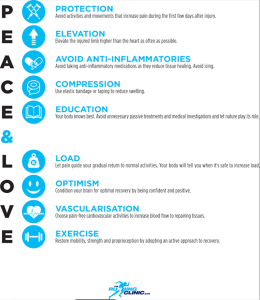For many years the standard advice for a pulled muscle, sprained ankle and other acute soft-tissue injuries has been RICE; Rest, Ice, Compression, Elevation. This is a widely known term, Familiar to many athletes which has evolved into other similar acronyms that encompass similar values. However, research has now shown that anti- Inflammatories can negatively impact long-term tissue healing with the use of ice potentially leading to impaired tissue repair and redundant collagen synthesis. These previous acronyms also focus on acute management and ignore subacute and chronic stages of healing. Therefore, the latest evidence suggests soft-tissue injuries need PEACE and LOVE
PEACE
Immediate Care
Protect
Unload or restrict movement for the first 1-3 days. This reduces bleeding and the risk of aggravating the injury. Prolonged rest can compromise tissue strength and quality. Let pain guide the cessation of protection
Elevate
Elevate the limb higher than the level of the heart to promote interstitial fluid flow out of the tissues. (There is weak evidence to support elevation however a low risk-to-benefit ratio is shown and therefore is recommended).
Avoid anti-Inflammatory modalities
The various phases of inflammation help repair damaged soft- tissues. The inhibition of inflammation from medication can negatively affect long-term tissue healing.
It is also recommended now to avoid ice. Ice is mostly an analgesic and can potentially disrupt inflammation, angiogenesis and revascularisation, delay neutrophil and macrophage infiltration as well as increase immature myofibers. This may lead to impaired tissue repair and redundant collagen synthesis. Despite the widespread use of ice for soft tissue injury, there is no high-quality evidence of its efficacy.
Compression
External mechanical pressure with tape or bandages helps to limit intra-articular oedema and tissue haemorrhage.
Educate
Therapists should educate patients on the benefits of an active approach to recovery. A passive approach early after an injury has insignificant effects on function and pain compared to an active approach and can even be counterproductive in the long term. Better education on the condition and its management will help to avoid over-treatment and the likelihood of unnecessary surgery and injections. The patient needs to have realistic expectations about what to expect and recovery times.
LOVE
Subsequent Management (After the first few days have passed)
Load
An active approach to movement and exercise benefits most patients with musculoskeletal disorders. Add mechanical stress early and resume normal activities as symptoms allow. Optimally loading the tissue without exacerbating pain promotes repair, and remodelling, and develops tissue tolerance and capacity of tendons, muscles, and ligaments through mechanotransduction.
Optimism
Psychological factors such as catastrophisation, depression and fear can represent barriers to recovery. Optimistic patient expectations are associated with improved outcomes and prognosis.
Vascularisation
Pain-free aerobic exercise should be started a few days after injury to boost motivation and increase blood flow to injured structures. Early mobilisation and aerobic exercise improves physical function.
Exercise
There is strong evidence supporting the use of exercise for the treatment of ankle sprains and for reducing the risk of recurrent injury. Exercise helps to restore mobility, strength, and proprioception early after injury. Avoid increased pain to ensure optimal repair during the subacute phase of recovery. Exercise should be progressed with pain as guidance.
Managing soft-tissue injuries is more than just short-term damage control. Treatment and management of soft-tissue injuries are forever changing and therefore it is important to be up to date with the latest evidence to ensure full recovery and a fast return to activity.




